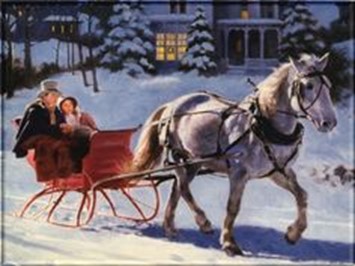
To listen to today’s reflection as a podcast, click here
If you can believe it, Jingle Bells used to be considered too racy to be connected with December 25.
James Lord Pierpont, the Savannah, GA church choir director who composed it in 1857, seems to have had Thanksgiving in mind.
He originally named it One Horse Open Sleigh. But after Mrs. Otis Waterman, one of his friends, declared that it was a “merry little jingle,” the modern name got traction. It quickly became a drinking song, with partygoers jingling their ice in their glasses while singing.
What really raised eyebrows, however, was the very notion of a young man and young woman taking off together in a sleigh.
The concept of dating didn’t arrive on the American scene until the 1920s, when single people were increasingly leaving their homes to seek work in large cities. Before that time, a young man would “court” a young woman by seeking permission to drop by her home. Family members would chaperone such callings. If the bachelor proved to be of good character, he might be left alone with her on the porch from time to time.
But parents and grandparents were never very far away.
A one-horse open sleigh was a different matter altogether. Beckoning a young lady to hop into a two-seater sleigh was the 19th-century equivalent of a hot guy pulling up to his girlfriend’s house in a Corvette.
Chaperones are nowhere in sight.
As another popular holiday song, Sleigh Ride, puts it, “we’re bundled up together, like two birds of a feather are we.” Exactly.
Those associations are now long gone. Jingle Bells has become a seasonal favorite, especially for kids. The song’s rhythm suggests a trotting horse. More than a few people have added “dashing through the snow” to their bucket list – taking a once-in-a-lifetime ride in a horse-drawn sleigh, followed by a mug of hot chocolate.
So how did couples become couples during the time of Mary and Joseph?
The great majority of marriages in the ancient world (as today in the Developing World) happened by arrangement. When the potential spouses were still children, two families would come to an understanding about their respective futures.
To modern Americans, this sounds like a nightmare. The last thing many of us are willing to surrender is our freedom – especially our freedom to choose a life partner.
But for centuries, arranged marriages have had a consistently positive track record.
In contemporary Western cultures, partners begin by falling in love with each other. Then they get married and hope their love will last. As many as half those marriages will not endure. In cultures where marriages are orchestrated for reasons other than love, partners begin by choosing to be committed to each other. Then they endeavor to fall in love. Such marriages tend to last longer and experience greater happiness.
Mary and Joseph would presumably have had a chance to ratify their parents’ decision. They would probably have spent some time together socially, and then agreed to marry.
Engagements during the time of Jesus involved an important public ceremony. The prospective groom would offer his beloved a glass of wine. If she accepted it from his hand, the families and community would rejoice, and plans for a wedding about a year later would get underway.
During that year, the engaged couple might live together, in close proximity to family, sharing everything but the same bed.
It was during this probationary period, however, that Mary began trying on maternity clothes. Joseph was no doubt devastated. How could his bride have betrayed him like this?
The story that God had supernaturally created a growing child in the womb of a peasant girl is still hard to fathom. It couldn’t possibly have been easy for either of them. “If you have never stood and looked at the Gospel and found it ridiculous, impossible, inconceivable,” writes author Tim Keller, “I don’t think you have really understood it.”
How did Mary respond to the angel Gabriel when he first told her of God’s startling plan?
Keller points out that she didn’t say, “It’s so clear now! I get it!” Nor did she say, “I love this plan and I’m excited to be part of it.” Instead, she said, “It doesn’t make sense to me at all, but I will do it.”
The courage of an unmarried teenage peasant girl is why we will celebrate Christmas one week from today.
And it’s why “merry little jingles” have become associated with a joy that’s impossible to put into words.
